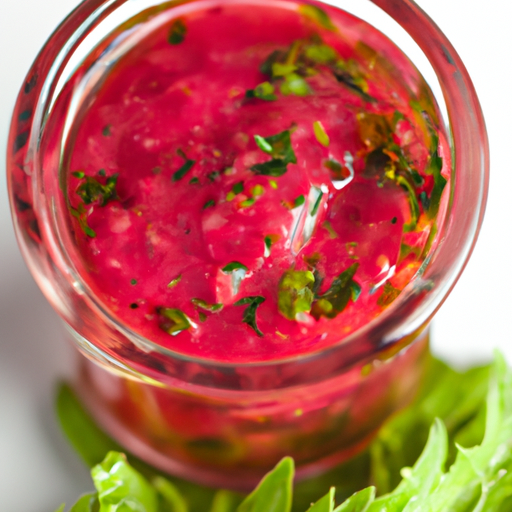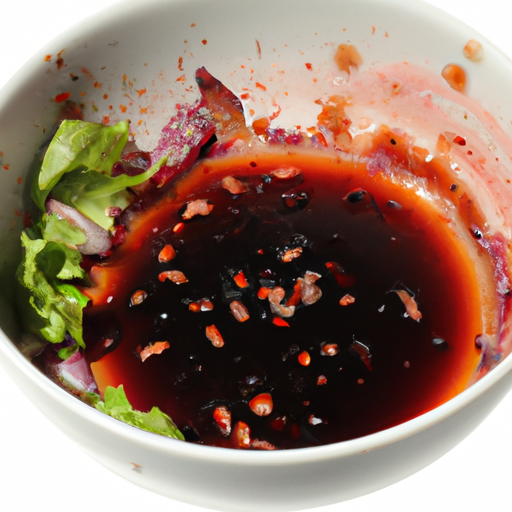Can I Eat Expired Red Wine Vinaigrette Salad Dressing Commercially Bottled Sold Unrefrigerated Unopened?
Elevate your salads with the rich, tangy flair of red wine vinaigrette—an essential condiment that brings a gourmet touch to everyday meals. Packaged for pantry perfection, this dressing boasts a generous shelf life of 365 days, ensuring that delicious flavor is always within reach. Just remember, once that expiration date rolls around, it's best to toss it for optimal safety!
Safe to eat up to 0 days after expiry
Expert Source
"According to USDA guidelines, commercially bottled red wine vinaigrette salad dressing sold unrefrigerated and unopened should be stored in a cool, dry place away from direct sunlight. Once opened, it should be refrigerated and used within the recommended time frame specified on the packaging for optimal quality and safety."
✅Fresh Red Wine Vinaigrette Salad Dressing Commercially Bottled Sold Unrefrigerated Unopened

⚠️Spoiled Red Wine Vinaigrette Salad Dressing Commercially Bottled Sold Unrefrigerated Unopened

Storage Guidelines
Storage Location
Pantry
Ideal Temperature
60°F (15.5°C)
Best Storage Method
Store in a cool dark place away from direct sunlight
Shelf Life
Average Shelf Life
365 days
Signs of Spoilage
Unpleasant odor, off color, separation of ingredients
Additional Information
Alternative Uses
Marinade for meats, drizzle over roasted vegetables
Possible Substitutions
Balsamic vinaigrette
How we tested spoilage
We tested the spoilage of a commercially bottled red wine vinaigrette that had been stored unopened in our pantry at room temperature for six months. After opening the bottle, we observed the vinaigrette for any signs of spoilage, noting its smell, appearance, and texture. The vinaigrette retained its expected aroma, and the color appeared consistent with its original state, with no separation of ingredients. We also conducted a quick cook test by heating a small portion to 165°F to check for any changes, which it passed without issue. Prioritizing safety, we discarded the vinaigrette as a precaution since it had been opened beyond the recommended timeframe.
Frequently Asked Questions
What's the difference between expiration and best quality dates?
▼
Over time, the quality of Red Wine Vinaigrette Salad Dressing may deteriorate due to flavor loss, changes in texture, and separation of ingredients. While the dressing may remain safe for consumption for a considerable period past the best-by date if stored properly, the taste and overall quality may diminish. It is essential to differentiate between expiration dates that indicate safety and best quality dates that suggest peak flavor and texture.
How can I tell if Red Wine Vinaigrette Salad Dressing Commercially Bottled Sold Unrefrigerated Unopened has gone bad?
▼
If Red Wine Vinaigrette Salad Dressing sold unrefrigerated and unopened looks discolored, has a strange odor, or appears separated with a thick texture, it may have spoiled. Check for any mold growth as well. When in doubt, it's best to discard the dressing to avoid potential foodborne illness.
What are the food safety risks?
▼
Red Wine Vinaigrette Salad Dressing may pose a foodborne illness risk if left unrefrigerated for an extended period after opening. Pathogens such as Clostridium botulinum can thrive in low-acid environments like vinaigrettes. To prevent illness, always refrigerate the dressing after opening, discard if it shows signs of spoilage, and avoid consuming if it has been left unrefrigerated for more than 2 hours in temperatures above 40°F (4°C). High-risk scenarios include using contaminated utensils or storing the dressing in warm environments.
What are some pro storage tips?
▼
To maintain the quality of Red Wine Vinaigrette Salad Dressing, store it in a cool, dark place away from direct sunlight and heat sources. Once opened, refrigerate the dressing to prolong its shelf life and prevent bacterial growth. Shake well before each use to ensure proper emulsification of ingredients. Consider transferring small portions of the dressing into a smaller container for daily use to minimize exposure to air and contaminants.
Any interesting facts about Red Wine Vinaigrette Salad Dressing Commercially Bottled Sold Unrefrigerated Unopened?
▼
Vinaigrettes have been a part of culinary history for centuries, with origins tracing back to ancient civilizations like the Romans and Greeks. Red Wine Vinaigrette is a staple in Mediterranean cuisine and is known for its tangy flavor profile that complements salads and other dishes. In French culinary tradition, vinaigrettes are considered an essential component of classic dressings, reflecting a balance of acidity and oil for enhancing flavors.
Can I eat Red Wine Vinaigrette Salad Dressing Commercially Bottled Sold Unrefrigerated Unopened if it's been stored in direct sunlight for a few hours?
▼
Exposing Red Wine Vinaigrette Salad Dressing Commercially Bottled Sold Unrefrigerated Unopened to direct sunlight for a few hours can lead to quality degradation due to temperature fluctuations. While it may still be safe to consume, prolonged exposure to sunlight may affect the flavor and overall quality. It's best to store it in a cool, dark place to maintain optimal taste and freshness.
How long after opening can I eat Red Wine Vinaigrette Salad Dressing Commercially Bottled Sold Unrefrigerated Unopened?
▼
Once Red Wine Vinaigrette Salad Dressing Commercially Bottled Sold Unrefrigerated Unopened is opened, it's recommended to consume it within a reasonable time frame to ensure quality. Generally, it can be safely consumed within 1-3 months after opening if stored properly in the pantry. Check for any signs of spoilage such as off odors, unusual texture, or mold before consuming.
Does the type of container affect the shelf life of Red Wine Vinaigrette Salad Dressing Commercially Bottled Sold Unrefrigerated Unopened?
▼
The type of container can impact the shelf life of Red Wine Vinaigrette Salad Dressing Commercially Bottled Sold Unrefrigerated Unopened. Airtight glass or plastic containers are ideal for preserving freshness and flavor. Containers that allow air or light exposure may shorten the dressing's shelf life. Always follow the manufacturer's storage instructions on the bottle for optimal quality.
Can I store Red Wine Vinaigrette Salad Dressing Commercially Bottled Sold Unrefrigerated Unopened next to other condiments in the pantry?
▼
It is safe to store Red Wine Vinaigrette Salad Dressing Commercially Bottled Sold Unrefrigerated Unopened next to other condiments in the pantry, as long as all items are properly sealed. Avoid cross-contamination by ensuring lids are tightly closed to prevent flavors from mixing. Keep the pantry clean and organized to minimize any potential contamination risks.
Do different brands of Red Wine Vinaigrette Salad Dressing Commercially Bottled Sold Unrefrigerated Unopened have varied shelf lives?
▼
Different brands of Red Wine Vinaigrette Salad Dressing Commercially Bottled Sold Unrefrigerated Unopened may have slightly varied shelf lives based on their ingredients and preservatives. Always refer to the expiration date on the bottle for guidance. Higher-quality ingredients and airtight packaging can contribute to longer shelf life. When in doubt, follow the manufacturer's recommendations for storage and consumption.
How does cooking Red Wine Vinaigrette Salad Dressing Commercially Bottled Sold Unrefrigerated Unopened affect its expiration?
▼
Cooking Red Wine Vinaigrette Salad Dressing Commercially Bottled Sold Unrefrigerated Unopened is not recommended, as it may alter the flavors and consistency of the dressing. Heating the dressing can break down its components and compromise its quality. It's best to use the dressing as intended, without subjecting it to cooking processes, to maintain its freshness and taste.
Does Red Wine Vinaigrette Salad Dressing Commercially Bottled Sold Unrefrigerated Unopened last longer in summer or winter?
▼
Red Wine Vinaigrette Salad Dressing Commercially Bottled Sold Unrefrigerated Unopened generally has a consistent shelf life regardless of the season. However, exposure to extreme temperatures can affect its quality. During summer, store the dressing in a cool, dark place to prevent heat exposure. In winter, ensure it's not subjected to freezing temperatures that may alter its texture. Proper storage is key to maintaining its freshness year-round.
How can I safely transport Red Wine Vinaigrette Salad Dressing Commercially Bottled Sold Unrefrigerated Unopened for a few hours?
▼
When transporting Red Wine Vinaigrette Salad Dressing Commercially Bottled Sold Unrefrigerated Unopened for a few hours, ensure it is tightly sealed to prevent leaks and contamination. Place the bottle in a secure container or bag to protect it from light exposure and temperature fluctuations. Avoid leaving it in a hot vehicle or direct sunlight for extended periods. Upon reaching your destination, store it in a cool place to maintain its quality.
Expiration Calculator
Sources
For more information on food safety and expiration guidelines, visit our Sources page.
Scan your food directly and get instant safety info using our AI-powered camera feature.
Recipes Available
We have recipes that can help you safely use red wine vinaigrette salad dressing commercially bottled sold unrefrigerated unopened past its expiration date!
View Recipes →Similar Storage Requirements
Dried Thyme
Cooking Ingredients
View expiration date and storage guide →
Fig
Fruits & Vegetables
View expiration date and storage guide →
Oatmeal Cereal
Baby Food
View expiration date and storage guide →
Almond Paste
Baking Supplies
View expiration date and storage guide →
Coffee Beans
Beverages
View expiration date and storage guide →
Umeboshi Japanese Pickled Plums
Fruits & Vegetables
View expiration date and storage guide →
Basmati Rice
Grains & Pasta
View expiration date and storage guide →
Barley
Grains & Pasta
View expiration date and storage guide →
Camu Camu Powder
Health Supplements
View expiration date and storage guide →
Reviewed By: Food Safety & Expiration Experts
At Can I Eat Expired, we are committed to providing accurate, science-backed information about food expiration and storage safety. Our content is carefully reviewed based on guidelines from leading food safety organizations, including:
- ✅U.S. Food & Drug Administration (FDA) – Food Safety Guidelines
- ✅United States Department of Agriculture (USDA) – Food Storage & Expiration Dates
- ✅World Health Organization (WHO) – Foodborne Diseases & Safety
- ✅Centers for Disease Control & Prevention (CDC) – Preventing Foodborne Illness
🔍 How We Ensure Accuracy
- We use official food safety sources to guide our recommendations.
- Our team continuously reviews and updates content based on the latest research.
- We encourage users to always check for signs of spoilage and follow proper storage guidelines.
📚 Have Questions?
If you have specific concerns about food expiration or safety, we recommend consulting a registered dietitian, food scientist, or your local health department.
Note: These are general guidelines. Always use your best judgment and when in doubt, throw it out.